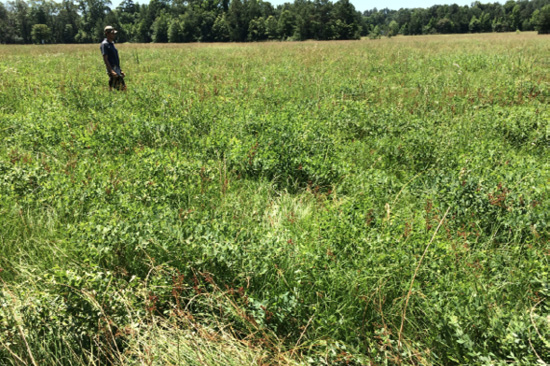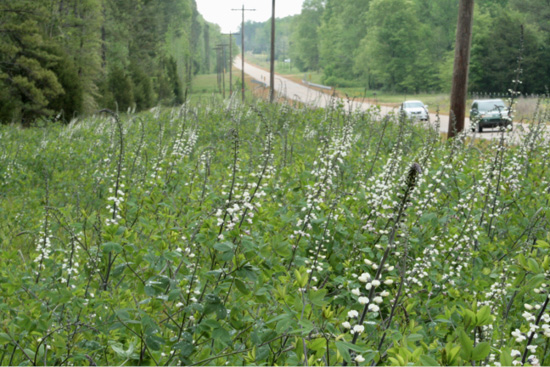Controlling White Wild Indigo (Baptisia alba) in Forages
Synonym: Baptisia lactea var. lactea
White wild indigo [Baptisia alba (L.) Vent.], or false indigo, is an herbaceous perennial shrub of the legume (Fabaceae) family. It is one of more than a dozen native Baptisia species found throughout eastern and midwestern North America. This particular showy plant is native to the eastern U.S. and is often identified by its distinctive white flower spikes produced in late spring or early summer in the Mid-south. White wild indigo is a desirable species in ornamental beds, native plantings, and pollinator habitat, but it is often viewed as a weed in pasture or livestock production. Because of its toxic properties, white wild indigo in pastures or hay fields poses health risks to grazing livestock.
Description
Growth
Established plants produce stout, smoky-purple stems that emerge in spring from a deeply branched root system. The main stem and sparsely branched side stems are smooth and gray-green, and they produce a mound of compound leaves. The trifoliate leaves are bluish-green and hairless. Ovate leaflets are up to 2 inches long with smooth margins and sometimes pointed ends (Figure 1). This mounding shrub usually reaches 3–6 feet tall and provides coarse-textured greenery to the spring landscape.
This plant is highlighted by the tall, highly visible inflorescence from which the name alba, meaning ‘white,’ is derived. This showy collection of white flowers occurs in an erect spike up to 2 feet long (Figure 2). Individual blossoms are pea-like in structure and contain petals that range from ½ to 1 inch long. Flowers bloom from mid- to late spring in the Midsouth (early April to mid-May in USDA hardiness zones 7–8). Pollinated and fertilized flowers develop green, oval fruit pods approximately ¾ inch long, before turning black upon seed maturity (Figure 3).

Propagation
White wild indigo is propagated by root division, stem cuttings, and seed. Seed pods begin to dry and split when fully ripened in mid- to late summer, when they release numerous kidney-shaped seeds. These are dispersed by gravity, birds, mammals, mechanical equipment, and surface water. Seed germination may require stratification because of the hard seed coat. Root division and stem cuttings result in quicker establishment, but flowering from new seedlings may not occur for 2–3 years.
Habitat
Plants are well distributed across the landscape, from open pastures and roadsides (Figures 4 and 5) to semi-shaded woodlands, tree lines, and clearings. This native is tolerant to well-drained to poorly drained, and fine-textured to medium-textured soils and possesses a deep taproot that improves its hardiness. Because of its desirable use in ornamental markets, plants may escape and establish in unwanted areas such as pastures and hayfields, where they become a threat to livestock.


Threat
Baptisia species contain the quinolizidine alkaloids baptisin and cytisine, similar to plants of the genus Lupine. If consumed by livestock, expected symptoms include nausea, vomiting, and diarrhea. However, due to high alkaloid concentration and unpalatability, consumption may not occur except when present in hay or when desirable forage is unavailable.
Control
Mechanical control with rotary mowers and similar equipment removes vegetation, but regrowth from roots is likely, especially if the plant’s life cycle is incomplete. Make sure plants do not reach seed maturity to avoid new seedlings in future years.
Chemical control measures have proven successful, and multiple options are available in forage and pastures. Several herbicides that selectively control this broadleaf weed are ideal for grass-dominant forage systems. Mississippi State University research has shown that GrazonNext HL (aminopyralid+2,4-D) at 1.2 or 2.4 pints per acre, Weedmaster (dicamba+2,4-D) at 3 pints per acre, Surmount (picloram+fluroxypyr) at 3 pints per acre, and Grazon P+D (picloram+2,4-D) at 1 or 2 quarts per acre provide at least 90 percent control when broadcast-applied to foliage before fruit set (Figure 6 and Table 1). Each of these products is active through plant foliage and root absorption with little to no detrimental effects to desirable grass forage.
Figure 6. All herbicide treatments extending below the red line indicate significant reduction in plants compared to nontreated plots.

|
Herbicide |
Product |
Rate (fl oz) Per Acre |
|---|---|---|
|
dicamba + 2,4-D |
Weedmaster |
48 |
|
fluroxypyr + picloram |
Surmount |
48 |
|
aminopyralid + 2,4-D |
GrazonNext HL |
19.2–38.4 |
|
picloram + 2,4-D |
Grazon P+D |
32–64 |
References
Davis, T. Z. (2023). Range plants of temperate North America. Merck Manual Veterinary Manual.
Gardner, R. (2014). Learn to grow bold, beautiful Baptisia. Fine Gardening (blog).
Hilty, J. (n.d.). White wild indigo (Baptisia alba macrophylla). Prairie Wildflowers of Illinois.
Kingsbury, J. M. (1964). Poisonous plants of the United States and Canada. Soil Science, 98(5).
Lady Bird Johnson Wildflower Center, University of Texas at Auburn. (n.d.). Baptisia alba. Plant Database.
Minnesota Department of Natural Resources. (n.d.). Baptisia lacteal var. lactea, rare species guide.
Missouri Botanical Garden. (n.d.). Baptisia alba. Plant Finder.
Russ, K. (2010). Baptisia (false or wild indigo). Home & Garden Information Center. Clemson University, South Carolina.
The information given here is for educational purposes only. References to commercial products, trade names, or suppliers are made with the understanding that no endorsement is implied and that no discrimination against other products or suppliers is intended.
Publication 3266 (POD-10-24)
By John D. Byrd, PhD, Extension/Research Professor, Plant and Soil Sciences, and David P. Russell, PhD, former Extension Associate.
The Mississippi State University Extension Service is working to ensure all web content is accessible to all users. If you need assistance accessing any of our content, please email the webteam or call 662-325-2262.




